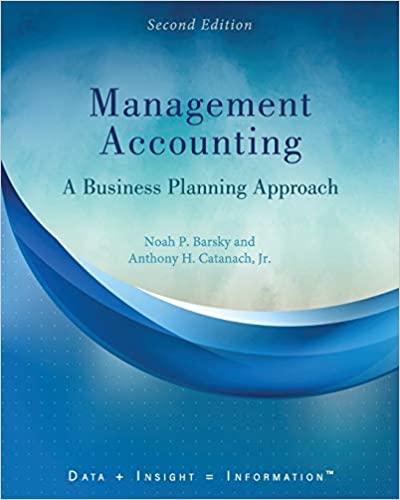Question
On January 1, 2018, Palmer Company acquired Snead Company. Palmer paid $880,000 for 80% of Sneads common stock. On the date of acquisition, Snead had
On January 1, 2018, Palmer Company acquired Snead Company. Palmer paid $880,000 for 80% of Sneads common stock. On the date of acquisition, Snead had the following balance sheet:
Snead Company
Balance Sheet
January 1, 2018
Assets Liabilities and Equity
| Accounts receivable | $120,000 | Accounts payable | $ 80,000 |
| Inventory | 80,000 | Bonds payable | 200,000 |
| Land | 120,000 | Common stock $1 par | 20,000 |
| Buildings | 400,000 | Paid-in capital in excess of par | 180,000 |
| Accumulated depreciation | (100,000) | Retained earnings | 224,000 |
| Equipment | 144,000 |
|
|
| Accumulated depreciation | (60,000) |
|
|
| Total assets | $704,000 | Total Liabilities & equity | $704,000 |
Buildings, which have a 20-year life, are understated by $200,000. Equipment, which has a 5-year life, is understated by $76,000. Any remaining excess is considered goodwill. Palmer uses the simple equity method to account for its investment in Snead.
Palmer and Snead had the following trial balances on December 31, 2019:
Palmer Snead
Company Company
| Cash | 48,000 | 264,000 |
| Accounts Receivable | 180,000 | 90,000 |
| Inventory | 240,000 | 112,000 |
| Land | 200,000 | 120,000 |
| Investment in Snead | 944,000 |
|
| Buildings | 1,600,000 | 400,000 |
| Accumulated Depreciation | (440,000) | (130,000) |
| Equipment | 300,000 | 144,000 |
| Accumulated Depreciation | (180,000) | (92,000) |
| Accounts Payable | (160,000) | (204,000) |
| Bonds Payable |
| (200,000) |
| Common Stock | (200,000) | (20,000) |
| Paid-In Capital in Excess of Par | (1,600,000) | (180,000) |
| Retained Earnings, January 1, 2019 | (650,000) | (284,000) |
| Sales | (1,600,000) | (700,000) |
| Cost of Goods Sold | 900,000 | 417,000 |
| Depreciation ExpenseBuildings | 60,000 | 15,000 |
| Depreciation ExpenseEquipment | 30,000 | 16,000 |
| Other Expenses | 320,000 | 196,000 |
| Interest Expense |
| 16,000 |
| Subsidiary Income | (32,000) |
|
| Dividends Declared | 40,000 | 20,000 |
| Totals | 0 | 0 |
On January 1, 2019, Palmer held merchandise sold to it by Snead for $24,000. This beginning inventory had an applicable gross profit of 25%. During 2019, Snead sold merchandise to Palmer for $150,000. On December 31, 2019, Palmer held $36,000 of this merchandise in its inventory. This ending inventory had an applicable gross profit of 30%. Palmer owed Snead $40,000 on December 31 as a result of this intercompany sale.
On January 1, 2018, Palmer sold equipment with a book value of $60,000 to Snead for $100,000. Depreciation is computed over a 5-year life, using the straight-line method.
Required: Please prepare the following:
- A value analysis, a D&D schedule, an amortization schedule and the schedule for the worksheet entries related to intercompany sales.
- In general journal entry form, the entries that would be made on a consolidated worksheet for the year 2019.
- The income distribution schedules to show the distribution of consolidated net income of $308,000 for the year 2019.
Step by Step Solution
There are 3 Steps involved in it
Step: 1

Get Instant Access to Expert-Tailored Solutions
See step-by-step solutions with expert insights and AI powered tools for academic success
Step: 2

Step: 3

Ace Your Homework with AI
Get the answers you need in no time with our AI-driven, step-by-step assistance
Get Started


